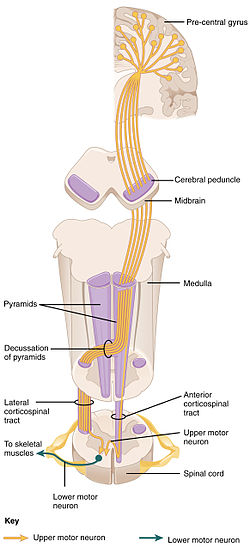184:. The lateral corticospinal tract neurons cross the midline at the level of the medulla oblongata, and controls the limbs and digits. The lateral tract forms about 90% of connections in the corticospinal tract; the vast majority cross over in the medulla, while the rest (about 2-3%) remain ipsilateral. The anterior corticospinal tract neurons, the remaining 10%, stay ipsilateral in the spinal cord but decussate at the level of the spinal nerve in which they exit, and control the trunk, shoulder and neck muscles.
29:
172:
are very large cells that are very visible under a microscope, and while they account for only about 5% of cells projecting to the spinal cord, they are often considered most crucial for communication of motor signals. These cells are notable because of their rapid conduction rate, over 70m/sec, the
141:
and premotor areas. Most of the neurons originate in either the primary motor cortex (precentral gyrus, Brodmann area 4) or the premotor frontal areas. About 30% of corticospinal neurons originate in the primary motor cortex, 30% more in the premotor cortex and supplementary motor areas, with the
198:
Because most (75-80%) of the connections cross the midline at the level of the medulla and others at the level of the spinal cord, each side of the brain is responsible for controlling muscles on the opposite side of the body.
202:
After patients are lesioned in some part of the pyramidal tracts, they are paralyzed on the corresponding side of the body. However, they can re-learn some crude, basic motions, just no fine movements.
166:
on either side of the medulla of the brainstem—and give their name as pyramidal tracts. Corticospinal neurons synapse directly onto alpha motor neurons for direct muscle control.
66:
195:
However, connections to the somatosensory cortex suggest that the pyramidal tracts are also responsible for modulating sensory information from the body.
206:
This implies that the connections to these tracts are crucial for fine movement, and only partial recovery is possible if they are damaged.
114:, controlling movements of the limbs and trunk. There are more than one million neurons in the corticospinal tract, and they become
284:
279:
Hall, Arthur C. Guyton, John E. (2005). Textbook of medical physiology (11th ed.). Philadelphia: W.B. Saunders. pp. 687–690.
267:
Kolb, B. & Whishaw, I. Q. (2014). An introduction to brain and behavior: Fourth edition. New York, NY: Worth
Publishers.
237:
Kolb, B. & Whishaw, I. Q. (2009). Fundamentals of human neuropsychology: Sixth edition. New York, NY: Worth
Publishers.
137:
The corticospinal tract originates in several parts of the brain, including not just the motor areas, but also the primary
73:
163:
61:
181:
146:. These upper motor neurons originate in layer V pyramidal cells of the neocortex, and travel through the
308:
177:
192:
The primary purpose of the corticospinal tract is for voluntary motor control of the body and limbs.
147:
255:
Purves, D. et al. (2012). Neuroscience: Fifth edition. Sunderland, MA: Sinauer
Associates, Inc.
303:
138:
8:
126:
103:
280:
159:
154:
at the base of the midbrain. Then both tracts pass through the brain stem, from the
142:
remaining 40% distributed between the somatosensory cortex, the parietal lobe, and
122:
143:
99:
115:
297:
151:
28:
95:
79:
111:
107:
162:. The corticospinal tract, along with the corticobulbar tract, form two
169:
173:
fastest conduction of any signals from the brain to the spinal cord.
49:
155:
176:
There are two divisions of the corticospinal tract, the
295:
263:
261:
233:
231:
229:
227:
225:
223:
221:
219:
258:
216:
27:
275:
273:
251:
249:
247:
245:
243:
118:usually in the first two years of life.
296:
148:posterior limb of the internal capsule
121:The corticospinal tract is one of the
270:
240:
16:Pyramidal white matter motor pathway
13:
14:
320:
74:Anatomical terms of neuroanatomy
150:in the forebrain, to enter the
98:motor pathway starting at the
1:
209:
182:anterior corticospinal tract
7:
187:
178:lateral corticospinal tract
10:
325:
132:
72:
60:
48:
43:
38:
26:
21:
55:tractus corticospinalis
125:, the other being the
33:Corticospinal pathway
139:somatosensory cortex
127:corticobulbar tract
104:lower motor neurons
102:that terminates on
92:corticospinal tract
22:Corticospinal tract
309:Spinal cord tracts
285:978-0-7216-0240-0
88:
87:
83:
316:
288:
277:
268:
265:
256:
253:
238:
235:
158:and then to the
123:pyramidal tracts
80:edit on Wikidata
77:
31:
19:
18:
324:
323:
319:
318:
317:
315:
314:
313:
294:
293:
292:
291:
278:
271:
266:
259:
254:
241:
236:
217:
212:
190:
144:cingulate gyrus
135:
100:cerebral cortex
84:
34:
17:
12:
11:
5:
322:
312:
311:
306:
290:
289:
269:
257:
239:
214:
213:
211:
208:
189:
186:
134:
131:
86:
85:
76:
70:
69:
64:
58:
57:
52:
46:
45:
41:
40:
36:
35:
32:
24:
23:
15:
9:
6:
4:
3:
2:
321:
310:
307:
305:
302:
301:
299:
286:
282:
276:
274:
264:
262:
252:
250:
248:
246:
244:
234:
232:
230:
228:
226:
224:
222:
220:
215:
207:
204:
200:
196:
193:
185:
183:
179:
174:
171:
167:
165:
161:
157:
153:
152:cerebral crus
149:
145:
140:
130:
128:
124:
119:
117:
113:
109:
105:
101:
97:
93:
81:
75:
71:
68:
65:
63:
59:
56:
53:
51:
47:
42:
37:
30:
25:
20:
304:Motor system
205:
201:
197:
194:
191:
175:
168:
136:
120:
108:interneurons
96:white matter
91:
89:
54:
112:spinal cord
44:Identifiers
298:Categories
210:References
170:Betz cells
116:myelinated
188:Function
180:and the
164:pyramids
160:medulla
133:Anatomy
110:in the
39:Details
283:
67:265580
94:is a
78:[
50:Latin
281:ISBN
156:pons
106:and
90:The
62:FMA
300::
272:^
260:^
242:^
218:^
129:.
287:.
82:]
Text is available under the Creative Commons Attribution-ShareAlike License. Additional terms may apply.
